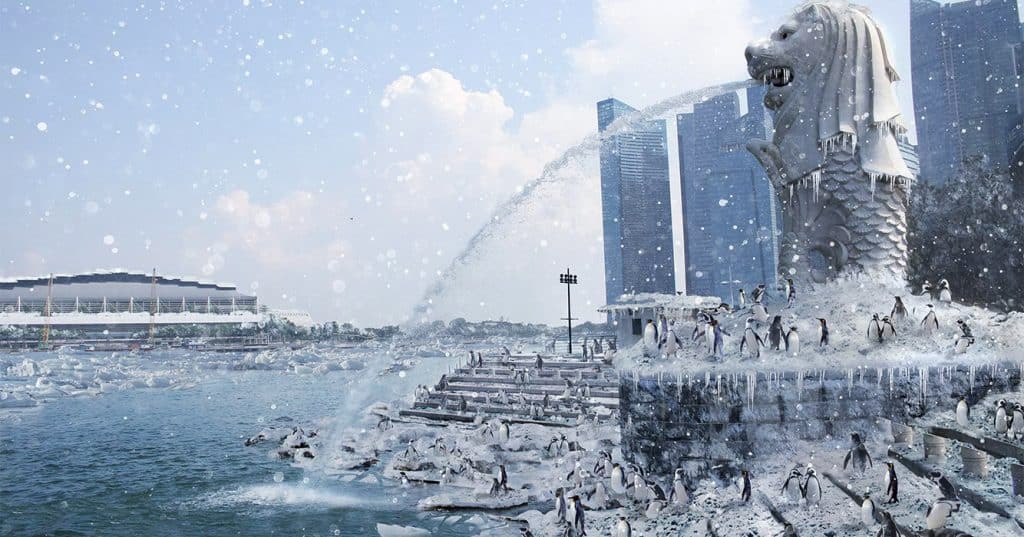As a perennially sweltering tropical island near the equator, Singapore seems an improbable candidate for experiencing snow. Snowfall conjures images of frigid winter wonderlands rather than steamy Southeast Asian cities.
Yet occasionally some speculate that technological advances might someday enable manufactured snow or freak weather changes could bring genuine snowflakes to this city-state.
This blog examines the climatic realities that make natural snowfall extraordinarily unlikely in Singapore, while also exploring creative concepts to simulate wintry weather indoors all year round for residents longing for a white Christmas.
The Geography and Climate of Snow-Free Singapore
Singapore’s location just over one degree north of the equator puts it squarely in a tropical climate unfavourable for snow. Temperatures average between 25 and 31 degrees Celsius year-round. As an island, its climate is also moderated by surrounding warm seas.
The last time significant snow occurred naturally in Southeast Asia was in 1858 on Mount Kinabalu, Borneo – over 1,000 kilometres from Singapore. Singapore’s highest point of 163 metres above sea level on Bukit Timah hill is tiny compared to snow-covered mountains elsewhere.
Its tropical rainforest environment traps heat and moisture. Singapore’s record low temperature is a relatively mild 19.4 degrees Celsius. Hence, the geography and climate of Singapore are exceedingly hostile for snowfall.
The Meteorological Origins of Snow
To understand Singapore’s snow-free reality, it is helpful to examine how snow meteorologically forms. Snow precipitates when atmospheric conditions enable water vapour to freeze into ice crystals.
Firstly, air temperatures must be cold enough, typically below 2 degrees Celsius. Secondly, the air must have sufficient moisture to form precipitation. As hot tropical air retains more evaporated moisture, this explains Singapore’s heavy rains. Finally, air must rise and cool to form clouds and precipitate ice.
Singapore’s uniformly warm climate prevents the cold air and variable cloud formations necessary for snow.
How Close Has Singapore Come to Snowfall?
In the 150 years of modern meteorological records, snow has never once been observed in Singapore. However, a few unusual weather events have sparked snow hopes. In early 1934, verdant Singapore hills reputedly turned briefly white. But it was likely frost, not snow. In 1954, a freak cold snap dipped temperatures unusually low to 20 degrees Celsius. Heavy rain also curiously fell with winds from the chilly north. But while frost formed that night, there was no snow. In early 2022, errant social media snow claims swirled during a wetter, cooler month. Unfortunately, they were just more snow fiction in the equatorial nation. Singapore has never come closer than a few flakes away from seeing snow.
Could Climate Change Bring Snow to Singapore?
Some propose climate change may eventually spawn flurries of snow in typically sweltering Singapore. After all, global warming increases climate variability and extremes. Singapore has already suffered unusual cold spells dipping near 20 degrees Celsius, including one week-long cold snap in 2021.
However, overall warming trends make sustained cold required for snow even more improbable. Singapore set a new record high of 36.9 degrees in 2022. Atmospheric warmth also holds more moisture that will likely translate to heavier rains rather than snow.
Ultimately, climate change is projected to raise Singapore’s temperatures, not lower them enough for snow.
How Unprecedented Arctic Cold can Create Snow
For snow to materialise, Singapore needs an extraordinary influx of chill from the Arctic region. This requires a dramatic breakdown of the polar vortex, which normally traps cold air far north. On rare occasions, a disturbed polar vortex can funnel frigid air southwards to lower latitudes. This resulted in ‘once in a generation’ snowfalls in Southeast Asia in early 2021.
However, even those flurries occurred in cooler northern mountain areas of Myanmar, Laos and Vietnam. For similar conditions to sufficiently cool Singapore, a seriously disrupted polar vortex would need to persist longer. But such extreme weather shifts remain highly speculative possibilities.
Could Cloud Seeding Technology Make it Snow?
Some have proposed using technology like cloud seeding to artificially stimulate snow in Singapore. Cloud seeding aims to enhance precipitation by injecting special substances like silver iodide into clouds.
However, this works best on plentiful clouds with supercooled water below freezing that only requires seeding agents to trigger snowfall. Singapore seldom experiences such supercooled clouds due to its warmer climate. Any clouds that form lack the raw wintry conditions for seeding to feasibly generate snow.
Unless accompanies by major weather manipulation, cloud seeding cannot conjure snow in Singapore’s skies.
How Snow Machines Can Offer Indoor Winter Wonderlands
While meteorologically unachievable outdoors, simulated indoor snow offers Singaporeans a taste of winter. Snow machines can blast out ice crystals or foam flakes, transformed through ice shaving and freezing processes. These provide snowy environments inside malls, hotels and attractions.
Resorts World Sentosa’s Snow City features a snow park with ice slides and sculptures maintained below 5 degrees Celsius. Changi Airport dazzles travelers with snowing displays during Christmas. Indoor snow offers a cool escape from Singapore’s heat and imaginations of wintery weather.
Virtual Reality Snow for All-Season Immersive Excitement
As virtual reality technology advances, Singaporeans can also experience simulated snowscapes anytime through augmented and virtual reality. VR winter sports allow practicing skiing and snowboarding with scenic mountain vistas. Dry slope facilities with artificial ski turf add physical sensation.
Virtual snowball fights bring fun too. While not matching genuine snow days, virtual reality can satisfy fascination with snow’s novelty in Singapore. Combining VR and indoor snow could provide the ultimate snow experience.
How Celebrating Winter Traditions Connects Us to Snow
Lacking snow hasn’t stopped Singapore from enthusiastically adopting winter holiday traditions. From festive Christmas light-ups to ice skating rinks, Singapore celebrates the year-end winter festive season with gusto. Malls deck out in sparkling Christmas decor while hotels erect grand gingerbread houses.
Even without snow, these appeals to the imagination through symbols of winter provide seasonal atmosphere. Shared global winter traditions build cross-cultural connections and spread joy.
Conclusion: Don’t Wait for Snow – Celebrate Singapore’s Distinctive Climate
In conclusion, the tropical climate of equatorial Singapore is highly unlikely to ever produce natural snowfall. Meteorological limitations prevent the precise cold conditions required. Climate change also looks set to increase, not decrease, temperatures. Technologically created snow remains confined indoors.
However, virtual snow, festivities and imagination offer everyone frosty fun. Rather than vainly await snow, Singaporeans should celebrate the real beauty of their nation’s unique weather and make the most of its glorious sunny Christmas seasons. Singapore’s climate is perfect just as it is – no snow necessary.

Goh Jun Cheng is the chief staff writer for SingaporeAirport.com. Jun Cheng graduated with a degree in journalism from Nanyang Technological University in Singapore.
He has over 5 years of experience writing about aviation, tourism, and lifestyle topics relevant to locals and visitors in Singapore. His articles provide insights into the rich culture, cuisine, and attractions of Singapore. Jun Cheng is an avid traveler who has visited over 15 countries.
When he is not writing or traveling, he enjoys photography, trying new foods, and hiking. As a longtime Singapore resident, Jun Cheng is passionate about sharing hidden gems and perspectives about his home country.




